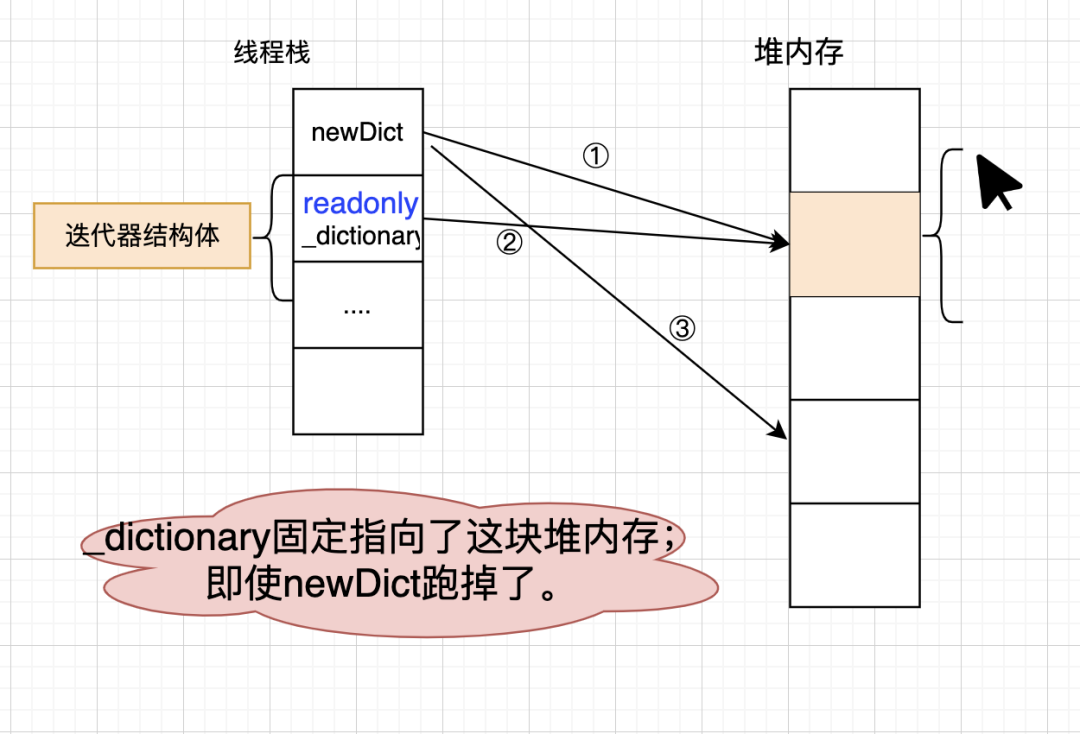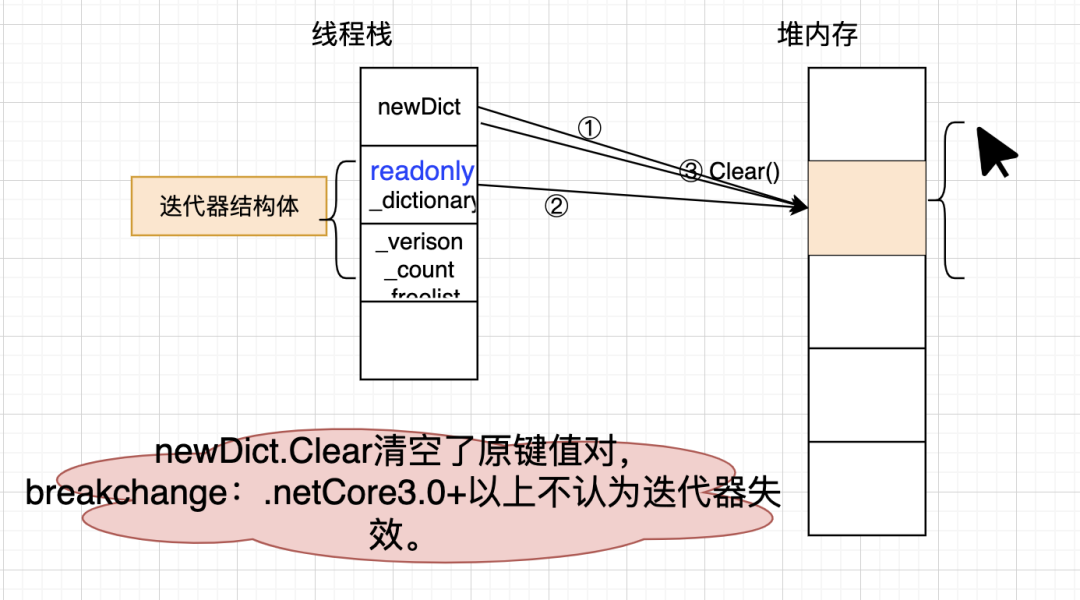我大意了,没有闪。

本文的诞生,是有感于一线码农大佬前几日公众号发文《Dictionary.Clear 和 new Dictionary() 有什么不同?》,里面有两个栗子让我虎躯一震。
1. 无心插花
void Example1()
{
var newDict = new Dictionary<string, string>();
newDict.Add("key1", "value1");
newDict.Add("key2", "value2");
foreach (var item in newDict)
{
newDict = new Dictionary<string, string>(); // 这里重新赋值
Console.WriteLine($"new : {item}");
}
}
void Example2()
{
var newDict= new Dictionary<string, string>();
newDict.Add("key1", "value1");
newDict.Add("key2", "value2");
foreach (var item in newDict)
{
newDict.Clear(); // 这里修改了原引用的数据,为啥不报错?
Console.WriteLine($"clear : {item}");
}
}这两个栗子输出的是:
new : [key1, value1]
new : [key2, value2]
clear : [key1, value1]这个输出是不是很奇怪:
(1) 栗子1重新new赋值难道不是修改了原字典对象newDict吗?foreach字典为什么不报InvalidOperation异常?
(2) 栗子2都肉眼可见的Clear字典了,foreach字典为什么还不报InvalidOperation异常?
2. Example1:抓的是周树人,与我鲁迅何干?
这个问题我大意了,没有闪😱😱。
这个问题其实与foreach没深入关系,其实就是多引用指向同一区域的问题,还是说下流程吧。
(1) 对字典做foreach, 内部会利用原对象newDict产生一个Enumerator迭代器。 IDictionaryEnumerator IDictionary.GetEnumerator() => new Enumerator(this, Enumerator.DictEntry);
https://github.com/dotnet/runtime/blob/45acd380b37c9ee883070a70a2ef2cb7eca77683/src/libraries/System.Private.CoreLib/src/System/Collections/Generic/Dictionary.cs#L1331
有关foreach本质,强烈推荐看这个:2021年了,
IEnumerator、IEnumerable还傻傻分不清楚?[1]。
(2) 关键是迭代器使用的新的readonly Dictionary<TKey, TValue> _dictionary;字段指向了原newDict指向的对象。
https://github.com/dotnet/runtime/blob/45acd380b37c9ee883070a70a2ef2cb7eca77683/src/libraries/System.Private.CoreLib/src/System/Collections/Generic/Dictionary.cs#L1367
(3) 于是在外部尝试重置newDict,与_dictionary无关,故会出现上面看似诡异的效果。
抓的是周树人,与我鲁迅何干。

3. Example2:.Net Core3.0+ breakChange
Example2肉眼可见地在foreach内变更了原迭代对象,竟然不报InvalidOperationException。
这个问题说来话长,真的说来话长。😪😪
循着源码看迭代器报InvalidOperationException异常的时机、查看字典Clear方法:
// https://github.com/dotnet/runtime/blob/64243bbf5e9ee53c0c4c5678f2cd8c7f1c9b4f6f/src/libraries/System.Private.CoreLib/src/System/Collections/Generic/Dictionary.cs#L1385
if (_version != _dictionary._version)
{
ThrowHelper.ThrowInvalidOperationException_InvalidOperation_EnumFailedVersion();
}
// https://github.com/dotnet/runtime/blob/cf258a14b70ad9069470a108f13765e0e5988f51/src/libraries/System.Private.CoreLib/src/System/Collections/Generic/Dictionary.cs#L223C5-L238C10
public void Clear()
{
int count = _count;
if (count > 0)
{
Debug.Assert(_buckets != null, "_buckets should be non-null");
Debug.Assert(_entries != null, "_entries should be non-null");
Array.Clear(_buckets, 0, _buckets.Length);
_count = 0;
_freeList = -1;
_freeCount = 0;
Array.Clear(_entries, 0, count);
}
}静态分析源码,貌似Dictionary认定字典正在变更的关键是verison字段发生变化,Clear()字典清空了原键值对、count、空闲空间等字段,确实没引起version字段变化。
围观微软官方Dictionary信源[2]:
属性 Count 设置为 0,并且也会释放对集合元素中其他对象的引用。容量保持不变。
此方法是 O (n) 操作,其中 n 是字典的容量。
仅限 .NET Core 3.0+ :可以安全地调用此可变方法,而不会使实例上的 Dictionary<TKey,TValue> 活动枚举器失效。这并不表示线程安全。

技能点:食之无用弃之可惜
ok, That'all, 这是看一线码农大佬昨日分享《DictionaryClear和newDictionary有什么不同[3]》的一点补充,[把原文给出的字典Example改成List Example]那又是一个有意思的话题,暂时不表,读者自行尝试。
本文没啥有用技能点,😓😓
一个是多引用指向同一片空间,另一个是源码逻辑的breakChange,不成体系,食之无用弃之可惜。
预告:今日既然聊到了C#字典,字典也是必考八股文,我会抽时间温习C# Dictionary的实现并给出自己的理解。
 最后啰嗦一句:全文原创,希望得到各位反馈,欢迎斧正交流, 若有更多进展,会实时更新到[左下角阅读原文]。
最后啰嗦一句:全文原创,希望得到各位反馈,欢迎斧正交流, 若有更多进展,会实时更新到[左下角阅读原文]。
引用链接
[1] 2021年了,`IEnumerator`、`IEnumerable`还傻傻分不清楚?: https://www.cnblogs.com/JulianHuang/p/14271285.html
[2] 微软官方Dictionary信源: https://learn.microsoft.com/zh-cn/dotnet/api/system.collections.generic.dictionary-2.clear?view=net-7.0#system-collections-generic-dictionary-2-clear
[3] Dictionary Clear和new Dictionary有什么不同: https://mp.weixin.qq.com/s/JUtr9TFRDfAvEeu6vJkI1w
成文耗时4小时,阅读5min,有用指数拉胯。
